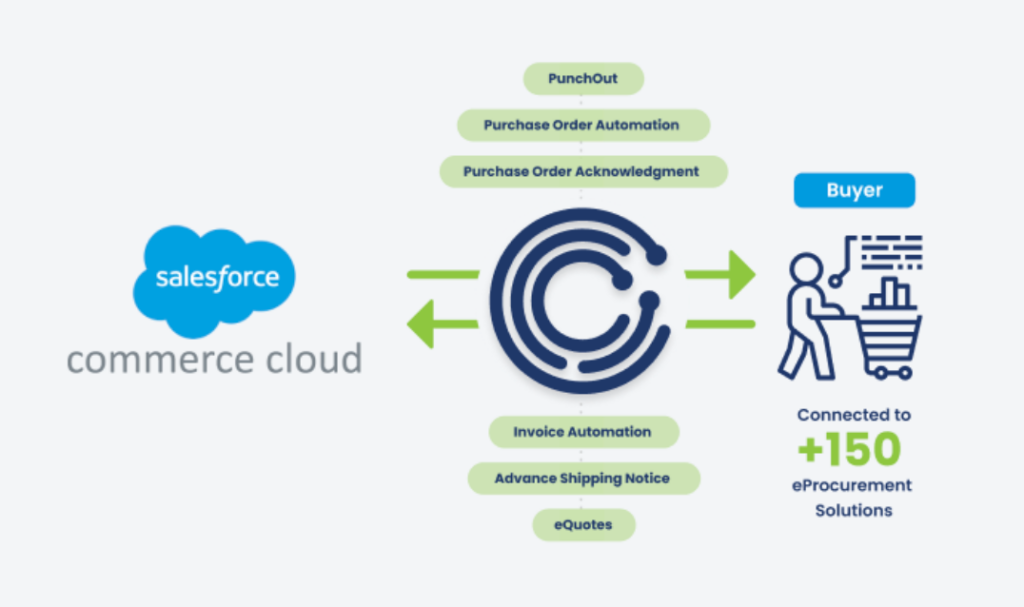Table of Contents
Salesforce Commerce Cloud consultants play an important role in helping businesses leverage the Salesforce platform to achieve their eCommerce goals. There are many Salesforce consulting services out there, and knowing who will work best for your business depends on the level of optimization, training, guidance, and insights your eCommerce business will need.
When implementing Salesforce Commerce Cloud, it’s a good idea to have an implementation partner to help you along the journey, but what benefits do Salesforce Commerce Cloud services have for your business processes?
Why should businesses work with a Salesforce Commerce Cloud consultant?
Salesforce Commerce Cloud consultants are game-changers in helping businesses maximize the value of their eCommerce investments and achieve success in the digital marketplace. Some of the key strengths of leveraging Salesforce Commerce Cloud consultants are:
- Platform Implementation: Consultants assist businesses in implementing Salesforce Commerce Cloud, including configuring the platform to meet specific requirements. Additional services include setting up storefronts, integrating with existing systems such as Customer Relationship Management (CRM) or Enterprise Resource Planning (ERP) technology, and customizing the platform to align with branding and workflows.
- Customization and Development: Another area that businesses often need help with is customizing and extending the functionality of Salesforce Commerce Cloud integration to address their unique business needs. This type of development can involve custom features, integrations, or extensions using the platform’s built-in tools, APIs, or third-party solutions.
- Optimization and Performance Improvement: Consultants also analyze eCommerce business operations as well as identify optimization and performance improvement areas. They may optimize website performance, streamline checkout processes, and implement best practices to enhance the overall user experience and drive conversion rates in a company’s online store.
- Training and Support: Salesforce Commerce Cloud consultants provide training and support to enterprise solutions teams to ensure they can effectively use and manage the Salesforce Commerce Cloud platform. This includes training on cross-cloud integration, Salesforce implementations, best practices, and ongoing support to address any technical issues or questions that may arise.
- Strategic Guidance: Consultants can also guide businesses on leveraging Salesforce Commerce Cloud to achieve their eCommerce development objectives. This may involve advising on digital marketing strategies, omnichannel integration, customer experience enhancements, and scalability planning, to name a few.
- Data Analysis and Insights: These firms also analyze eCommerce data to give businesses valuable insights into customer behavior, sales trends, and performance metrics that can help enterprises leverage data to make informed decisions and drive business growth.
- Upgrades and Maintenance: Staying up-to-date with the latest features and enhancements of Salesforce Commerce Cloud by managing platform upgrades and performing ongoing maintenance activities ensures businesses continue to benefit from the latest innovations and improvements.
Who can offer your business the best Salesforce Consulting services?
The road to the right Salesforce partners starts with knowing who’s on the market and who suppliers can partner with throughout the end-to-end process to deliver the best result.
TradeCentric
Although TradeCentric is not primarily a Salesforce Commerce Cloud consulting business, our partnership with Salesforce Commerce Cloud runs deep. We also work closely with systems integrators who empower companies to confidently scale commerce on a complete platform to drive sales on any customer touchpoint.
TradeCentric’s mission with partners is to serve thousands of mutual B2B buyer and supplier customers, driving faster time to value and improved expansion opportunities. We are a proud partner of several Commerce Cloud systems integrators, including:
Saltbox
With multiple Salesforce accreditations and certifications, Saltbox is an architecturally driven commerce and Salesforce solutions partner that is focused on customer-tailored strategies and implementation services for Salesforce commerce, order support, and connected end-to-end buying journeys.
Whether you’re trying to modernize operations, a company trying to create connected experiences across their B2B and D2C channels, or an established organization opening up new buying channels for your customers, Saltbox has the relevant experience to make your goals a reality.
Slalom
At the intersection of business, technology, and humanity is Slalom, a Commerce Cloud consulting company whose strategy is to create digital product building and beyond with the right mix of services to accelerate your vision with holistic, practical solutions.
Slalom is also a technological partner with Salesforce, leveraging Salesforce technology to push boundaries, embrace disruption, and deliver innovative industry solutions that transform customers’ businesses, helping organizations stay ahead.
6Street
Another reputable Salesforce partner for companies seeking assistance with Commerce Cloud is 6Street, which has served as a trusted advisor since 2012, helping organizations navigate the ever-changing tech landscape and meeting the evolving needs of organizations.
Having worked with brands like Coca-Cola, Frito-Lay, and Symantec, 6Street and their team of Salesforce developers can help you take your eCommerce from an online store to one of your most scalable solutions.
Shift7
A founding member of the Salesforce B2B Commerce Advisory Board and one of only six expert-level partners for Commerce Cloud globally, Shift7 specializes in turning your B2B commerce cloud experience into one that delights and drives down the cost of sales.
Shift7 is uniquely qualified to put your unique customer experiences to work on your existing core platform.
Trifecta Technologies
For over 30 years, Trifecta Technologies has been a trusted advisor to some of the most successful global brands, including Trex and Knoll. A Salesforce partner since 2012, Trifecta strategizes, implements, and extends solutions across the Salesforce Customer Success Platform, redefining and unifying commerce to create a truly connected Customer 360 experience with cross cloud integration.
Serving the eCommerce, Manufacturing, and retail industries, Trifecta offers Salesforce consulting, strategic roadmapping, and health checks to ensure your organization is set up for success. Trifecta also offers managed services so companies can focus more energy on their eCommerce business.
ForeFront
ForeFront has solutions deployed to over 70 countries worldwide and has over 25 years of experience. ForeFront has the ability to integrate Salesforce solutions with its award-winning capabilities, leveraging its any-to-any integration expertise.
Additionally, ForeFront has award-winning Service Cloud solutions that include predictive field asset support, case deflection, complex entitlement/work orders, smart omnichannel routing and preventive insights. As a result, clients optimize profit from people, processes, and products.
Hero Digital
Hero Digital is another Salesforce Commerce Cloud consulting partner to consider during your digital transformation. If your business needs a team of Salesforce Commerce Cloud developers to help you keep your business at the forefront of modern B2B eCommerce development, Hero Digital solves your hardest problems with an offering that fits your business goals.
Combining commerce, content, and marketing technology to increase efficiency, reduce operating costs, and enhance digital enablement, Hero Digital develops and integrates a cohesive CX technology stack to bring the ecosystem to life while optimizing and ensuring interoperability with existing systems and panthers.
Achieve more scalable solutions with your Salesforce platform today

Salesforce Commerce Cloud consultants assist businesses in maximizing the value of their investment by providing expertise in the implementation, customization, and optimization of the platform. They help configure storefronts, integrate with other systems, and customize features to meet specific needs.
Consultants also optimize performance, improve user experience, and increase conversion rates through strategic recommendations and facilitate seamless integration with other systems, such as ERP and CRM, ensuring data consistency and enabling a comprehensive technology stack.
Want to learn more about how TradeCentric partners with Salesforce Commerce Cloud consultants? Check out TradeCentric’s strategic partner ecosystem and discover the potential of B2B connected commerce.




